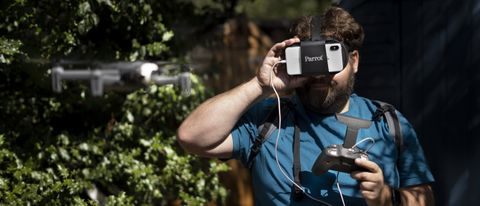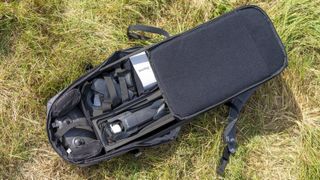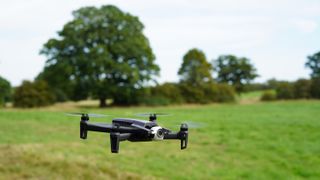
When you purchase through links on our site, we may earn an affiliate commission. Here’s how it works.

Chasing the top spot in the global drone market, Parrot’s Anafi had to be pretty special, and it was, with still-unmatched features like the full 180-degree tilt on the gimbal and batteries with built-in USB charging ports. The addition of FPV might seem frivolous fun at first, but it actually improves things from a photographer's perspective as well as being a great deal of fun. The addition of some long-requested software features are just the icing on the cake.
TODAY'S BEST DEALSWhy you can trust Digital Camera World
Our expert reviewers spend hours testing and comparing products and services so you can choose the best for you. Find out how we test.
To be 100% honest, we had mixed feelings about testing the Parrot Anafi FPV. There’s no question that the 21-megapixel camera drone is a well-engineered aircraft with much to offer, but donning 'first-person view' goggles was, we thought, the preserve of the clique of talented pilots who race quadcopters at over 100mph. We hadn’t yet made the connection with photography, video-making, or just plain fun.
The Parrot Anafi was originally launched – without the FPV option – in 2018, pushing the DJI Mavic Air into a distinct second place in many respects with class-leading 25-minutes flight time and the unique ability to tilt its camera all the way up as well as down, and a cunning lossless zoom taking advantage of its 21 megapixels. The drone is light, while its controller somewhat chunky. Since its original launch a Thermal version has been added, as well as an Extended Package with three batteries and a bigger case. Now this Anafi FPV version gives you a kit version with controller and goggles…

By choosing to co-opt your phone as the Cockpitglass 3’s display, Parrot keep costs down but the trade off is access to controls. Parrot addresses this with two sprung buttons, one that calls up a menu which is then operated using the joysticks (the Anafi will politely hovers in place). Once you’ve made your adjustment, hitting the same button reverts to FPV view and the joystick returns to flight control mode. The other button invokes your phone’s camera, so you never need to push the goggles up to quickly ground yourself.
Each button is one end of a sprung lever which taps a spot on the phone’s screen. That neatly sidesteps a fiddly sync process, and eliminates any battery weight on the head. The only other adjustments are via velcro on the three straps and width adjustment for the optics (no focus control).

Complementing the Cockpitgoggles is a chic new backpack. Each of Parrot’s Anafi kits has such a nice case or bag that it’s hard not to see potential accessory vendors feeling unwanted. This might be the best of the bunch, with Anafi’s signature grey textured fabric. It’s compact and, when it’s belt is worn, it can be rotated to serve as a front-pack (a little like a paranoid tourist might), then opened 90 degrees like a shelf. This and the Hand Launch feature mean that you can be in the air without even bending down!
The same Skycontroller 3 remote offers more functionality for photographers, thanks to the latest update to FreeFlight 6. Following photographers’ requests, it’s now possible to use one of the shoulder levers as EV or Shutter Speed adjustment. Since the Anafi’s launch the app has acquired plenty more features, too – manual control of all the key exposure functions, and white balance, as well as a histogram and “zebra” blown highlights overlay. These can even be found via the Cockpitglasses menu.


• Parrot Anafi
Camera sensor: 1/2.4-inch 21-megapixel
Effecive focal length of lens: 23mm (26mm for video)
ISO: 100-3200
Shutter: Electronic (1 to 10,000 sec)
Video resolutions: 4K Cinema (4,096x2,160) or 4K UHD (3,840x2,160) at 24/25/30fps, or 1080P at 24/25/30/48/50/60fps
Still image max resolution: 4608 × 3456 (or 5,344 x 4,016 with fish-eye distortion)
Take-off weight: 320g
Max Range: 4km / 2.5mi
Size (folded): 168 x 83 x 49mm
Battery: 25-min

• Skycontroller 3
System: Dual Wi-Fi (realistic range 1.1km)
Buttons: 2x sticks, 2x analog triggers, 2x shoulder buttons, Take off button, return to home button

Popping the goggles from their compact storage position is as easy as pulling the moulded rubber and the effect is satisfying. Perhaps it isn’t as sturdy as the DJI Goggles , but with a built-in screen and battery they cost considerably more.
Getting up and running is a simple matter of choosing FPV in the updated FreeFlight 6 then clipping in the phone (you do need to take care to line up the centre of the screen). The communication cable will still dangle between phone and Skycontroller 3 (the remote), but of course you won’t see it!
Our iPhone XS Max seemed to offer perfect video (in or out of its case). The actual video preview, as with most drones, is 720p meaning high PPI screens will only improve the menu & icons. Our only real complaint was that the weight of the phone seemed to rest on the bridge of the nose, where the goggles are nearly devoid of padding.
The drone’s range is not affected, though pointing the controller in the optimal direction is somewhat harder – Parrot’s on-screen guidance helps but it’s best to set a short Geofence (as Parrot do by default).
Tweaking the settings is immediately natural; the battery does deplete while the Anafi hovers while you tweak, but that is true without FPV mode. The advantage is that in shielding of the goggles you get a much better impression of the true effect of your manual settings compared to a phone screen in the sun.
Whether you’re just flying for fun, or getting low/tight action footage, the new Dynamic Horizon effect in Arcade mode very quickly makes you feel like you’re blasting through the landscape like a miniature Luke Skywalker. The (easily hidden) on-screen graphics have a hint of targeting scope, too… will it be able to hit that exhaust port?